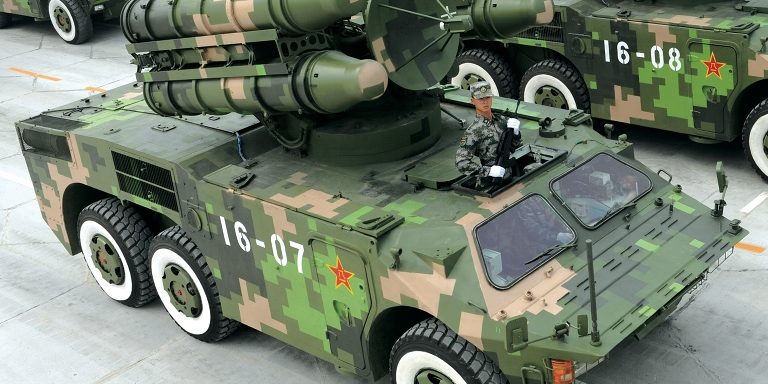Quick Facts
| PRC/NATO Designation | HQ-7 / FM-80 (CSA-4) |
| Variants |
HQ-7A / FM-90 (CSA-5) HQ-7B (CSA-7) HHQ-7 (naval variant) |
| Mobility and Role | Ground-based/road-mobile; short-range and point air defense |
| Range | 0.7 – 12 km (HQ-7), 0.7 – 15 km (HQ-7B) |
| Sensors |
HQ-7: J-Band acquisition radar, detect and track targets at range of 17 km HQ-7B: S-Band AESA radar, detect and track at range of 20 km |
| Targets | Low-flying aircraft, cruise missiles, air-to-ground missiles, and anti-radiation missiles |
| Status/Exports | Operational; Exported to Algeria, Bangladesh, Iran, Pakistan, and Turkmenistan |
| Designer/Producer | China Aerospace Science and Industry Corporation (CASIC) |
Overview
The Hong Qi-7 (HQ-7) is a reverse-engineered copy of the French Crotale missile defense system, one of the most successful air defense systems ever developed. Crotale derivatives comprise three hundred systems deployed in fifteen nations.[i]The HQ-7 is designed for rapid deployment in multiple theatres.[ii]The PLA estimates its single-shot kill probability as 80 percent.[iii]The primary differences between the HQ-7B and earlier HQ-7 systems are upgrades to the acquisition radar and the P4R vehicle:[iv]The original HQ-7’s j-band acquisition radar can detect up to 30 targets and track 12 of them at a range of 17 km.[v]By contrast, the HQ-7B features s-band active electronically scanned array (AESA) radar, which can detect up to 48 targets and track 24 of them at a range of 20 km.[vi]A normal battery includes one vehicle with acquisition radar and three TELAR vehicles, which are equipped with four missiles each.[vii]The Naval variant FM-90 (N) is proposed for export and can be mounted on frigates and destroyers. Each launcher has an eight-missile carrying capacity that can be used t intercept sea-skimming anti-ship missiles.[viii]
Strategic Implications
The design philosophy for the French Crotale—off of which the HQ-7 is based—is to fill the role of a short-range, low-altitude, concealed interceptor with a fast reaction time. The development of hypersonic Soviet aircraft with short radar display times spurred French development of the Crotale, which has a reaction time of less than ten seconds and a reload time of two minutes.[ix]Though the original HQ-7 system is outdated, today Beijing uses the HQ-7B as a short-range level of point defense against low-flying aircraft and tactical ballistic missiles, primarily for coastal and border defense of industrial and military assets. Moreover, HQ-7Bs exported to Iran and Pakistan could prove problematic for older generations of U.S. aircraft or short-ranged artillery in the event of a conflict.
Timeline
November 2016: Turkmenistan reveals it possesses Chinese FM-90 batteries in a military parade.
May 2015: Pakistan imports at least two HQ-7B batteries from China.[x]
2009: The PLA begins widescale deployment of the armored HQ-7B.[xi]
1999: Iran unveils the Shahab Thaqeb, a clone of the Chinese HQ-7A jointly developed with CASIC.[xii]
1998: CASIC unveils the upgraded HQ-7A, featuring improved radar and range, as well as the FM-90 export version.[xiii]
1989: China unveils an export version of the HQ-7, the FM-80, at the Dubai Aerospace Show.
1986: CASIC certifies mass production of the HQ-7.[xiv]
1983: CASIC completes testing of a Crotale clone, the HQ-7.[xv]
1979: The PLA imports four Thomson-CSF Crotale systems from France and begins the process of reverse-engineering.
1978: Thomson-Houston begins mass production of the Crotale, manufacturing 300 systems.
1967: Thomson-Houston and Rockwell International in France begin conceptual development of the Crotale for South Africa.[xvi]
Recent News
References
[i]http://www.military-today.com/missiles/hq7.htm
[ii]http://www.ausairpower.net/APA-HQ-7-Crotale.html#mozTocId527286
[iii]http://www.airforce-technology.com/news/newsbaf-inducts-fm-90-missile-system
[iv]http://www.ausairpower.net/APA-HQ-7-Crotale.html
[v]http://www.military-today.com/missiles/hq7.htm
[vi]http://www.military-today.com/missiles/hq_7b.htm
[vii]Ibid.
[viii]Ibid.
[ix]http://www.ausairpower.net/APA-HQ-7-Crotale.html#mozTocId527286
[x]http://www.defenseworld.net/news/12959/Pakistan_Inducts_Chinese_Air_Defense_Missile_System#.WyQlqC-ZMlU
[xi]http://www.military-today.com/missiles/hq_7b.htm
[xii]http://www.military-today.com/missiles/hq7.htm
[xiii]http://www.military-today.com/missiles/hq7.htm
[xiv]http://www.military-today.com/missiles/hq7.htm

